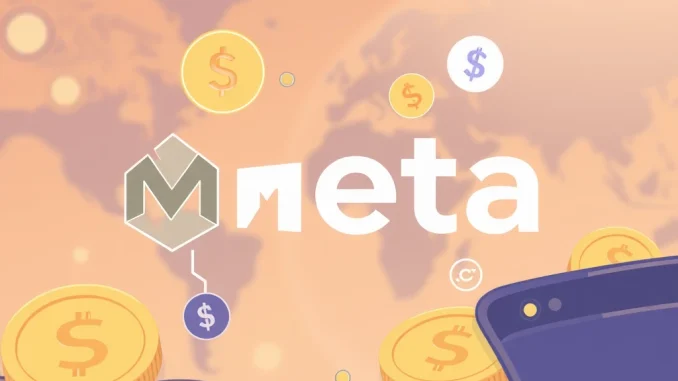
Just three years after its ambitious Diem stablecoin project was shut down amidst significant regulatory pressure, tech giant Meta is reportedly back in the ring. Yes, you heard that right. New reports suggest that Meta is once again exploring the possibility of introducing a Meta stablecoin, potentially signaling a renewed push into the world of digital currencies.
Meta’s Renewed Crypto Ambitions: What Are the Latest Meta Crypto Plans?
According to reports from Unfolded and Fortune Crypto, Meta is currently engaged in internal discussions regarding the potential introduction of stablecoins. This isn’t just idle chatter; sources indicate that these talks are being led by a Vice President of product who brings significant experience from the cryptocurrency industry. Furthermore, Fortune Crypto specifically noted that Meta is in active discussions with various cryptocurrency companies.
The primary focus of these reported discussions? Utilizing stablecoins as a means of payment. This aligns somewhat with the original vision for Diem (formerly Libra), which aimed to facilitate low-cost global payments.
Key takeaways from the reports:
- Meta is actively discussing stablecoin possibilities internally.
- A product VP with crypto background is leading the effort.
- Discussions are happening with external cryptocurrency companies.
- The primary use case being explored is payments.
Learning from the Past: The Diem Stablecoin Experience
For those who followed the crypto space a few years ago, the name Diem (and before that, Libra) brings back memories of a massive, yet ultimately unsuccessful, attempt by Meta (then Facebook) to launch a global digital currency. The Diem stablecoin project was ambitious, aiming to create a stable digital currency backed by a reserve of assets, managed by an independent association of companies.
However, the project faced intense scrutiny and opposition from regulators worldwide who raised concerns about financial stability, money laundering, and Meta’s potential influence over a global currency. The regulatory hurdles proved insurmountable, leading to the project’s eventual shutdown and the sale of its assets in early 2022.
Meta’s reported return to stablecoins suggests they may have learned valuable lessons from the Diem experience. Perhaps they are considering a different approach, one that might be less globally disruptive or more palatable to regulators. The focus on payments and discussions with existing crypto companies could indicate a strategy involving integration with existing infrastructure rather than building an entirely new ecosystem from scratch.
Potential for Cryptocurrency Payments on Meta Platforms
The explicit mention of stablecoins for cryptocurrency payments is particularly interesting. Imagine the potential scale if Meta were to integrate stablecoin payments across its vast ecosystem, which includes Facebook, Instagram, and WhatsApp.
Potential use cases could include:
- Sending money to friends and family across borders cheaply and quickly via WhatsApp or Messenger.
- Facilitating e-commerce transactions directly within Facebook Shops or Instagram Shopping.
- Enabling micropayments for content creators or digital goods within Meta’s platforms, including future metaverse applications.
- Allowing advertisers to pay for campaigns using stablecoins.
Such an integration could significantly boost the adoption and everyday use of stablecoins, bringing digital currency payments to billions of users globally. It could bridge the gap between traditional social media/e-commerce and the burgeoning crypto economy.
What Does This Mean for Facebook Crypto and Beyond?
While these are still early discussions, the fact that Meta is exploring stablecoins again is significant news for the broader crypto market. A successful launch and integration of a Facebook crypto payment solution (even if branded differently) could:
- Legitimize stablecoins further in the eyes of the public and businesses.
- Drive innovation in stablecoin technology and regulation.
- Increase competition among existing payment providers and stablecoin issuers.
- Potentially pave the way for other large tech companies to explore crypto integrations.
However, significant challenges remain. Regulatory approval is paramount, and Meta will need to demonstrate a clear understanding of and compliance with financial regulations in every jurisdiction it operates. Building trust with users after the Diem saga will also be crucial. The competitive landscape has also evolved, with existing stablecoins like USDT and USDC holding significant market share, and numerous fintech companies offering innovative payment solutions.
Conclusion: A Cautious Return?
Meta’s reported exploration of stablecoins three years after the Diem shutdown is a compelling development. While details are scarce, the focus on payments and engagement with existing crypto companies suggests a potentially more targeted and pragmatic approach compared to the previous global currency ambition. Whether Meta can navigate the complex regulatory environment and successfully integrate stablecoins into its vast user base remains to be seen. But for now, the prospect of a return to ‘Facebook crypto’ in some form is back on the table, hinting at a potentially exciting, albeit challenging, future for digital payments within the social media giant’s ecosystem.



